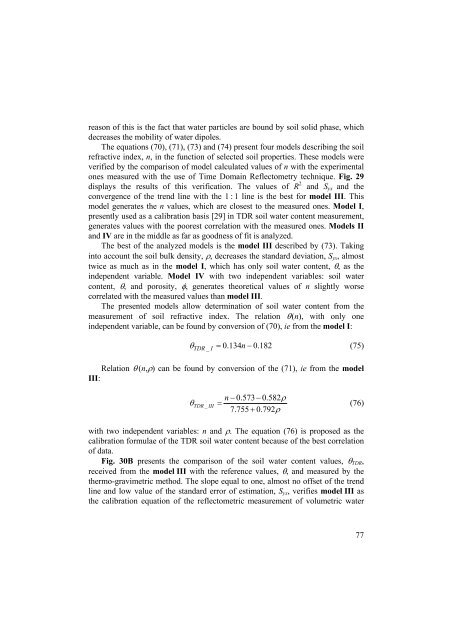ekS - Instytut Agrofizyki im. Bohdana DobrzaÅskiego PAN w Lublinie ...
ekS - Instytut Agrofizyki im. Bohdana DobrzaÅskiego PAN w Lublinie ...
ekS - Instytut Agrofizyki im. Bohdana DobrzaÅskiego PAN w Lublinie ...
You also want an ePaper? Increase the reach of your titles
YUMPU automatically turns print PDFs into web optimized ePapers that Google loves.
eason of this is the fact that water particles are bound by soil solid phase, which<br />
decreases the mobility of water dipoles.<br />
The equations (70), (71), (73) and (74) present four models describing the soil<br />
refractive index, n, in the function of selected soil properties. These models were<br />
verified by the comparison of model calculated values of n with the exper<strong>im</strong>ental<br />
ones measured with the use of T<strong>im</strong>e Domain Reflectometry technique. Fig. 29<br />
displays the results of this verification. The values of R 2 and S yx and the<br />
convergence of the trend line with the 1 : 1 line is the best for model III. This<br />
model generates the n values, which are closest to the measured ones. Model I,<br />
presently used as a calibration basis [29] in TDR soil water content measurement,<br />
generates values with the poorest correlation with the measured ones. Models II<br />
and IV are in the middle as far as goodness of fit is analyzed.<br />
The best of the analyzed models is the model III described by (73). Taking<br />
into account the soil bulk density, ρ, decreases the standard deviation, S yx , almost<br />
twice as much as in the model I, which has only soil water content, θ, as the<br />
independent variable. Model IV with two independent variables: soil water<br />
content, θ, and porosity, φ, generates theoretical values of n slightly worse<br />
correlated with the measured values than model III.<br />
The presented models allow determination of soil water content from the<br />
measurement of soil refractive index. The relation θ(n), with only one<br />
independent variable, can be found by conversion of (70), ie from the model I:<br />
θ = 0.134n<br />
− 0.182<br />
(75)<br />
TDR _ I<br />
Relation θ (n,ρ) can be found by conversion of the (71), ie from the model<br />
III:<br />
0.573 − 0.582ρ<br />
θ _ = n −<br />
TDR III<br />
(76)<br />
7.755 + 0.792ρ<br />
with two independent variables: n and ρ. The equation (76) is proposed as the<br />
calibration formulae of the TDR soil water content because of the best correlation<br />
of data.<br />
Fig. 30B presents the comparison of the soil water content values, θ TDR ,<br />
received from the model III with the reference values, θ, and measured by the<br />
thermo-grav<strong>im</strong>etric method. The slope equal to one, almost no offset of the trend<br />
line and low value of the standard error of est<strong>im</strong>ation, S yx , verifies model III as<br />
the calibration equation of the reflectometric measurement of volumetric water<br />
77
















